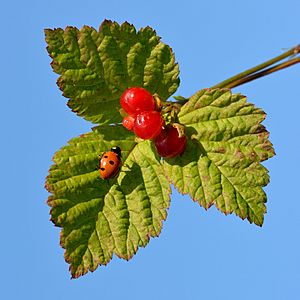Stone bramble facts for kids
Quick facts for kids Stone bramble |
|
|---|---|
 |
|
| Scientific classification | |
| Genus: |
Rubus
|
| Species: |
saxatilis
|
| Synonyms | |
|
|
The stone bramble (scientific name: Rubus saxatilis) is a type of bramble plant. You can find it all over Europe and Asia, from countries like Iceland and Spain all the way to China. It also grows in Greenland.
This plant has green stems that usually grow to be about 20 to 60 centimeters (8 to 24 inches) tall. These stems have tiny, needle-like prickles. Its leaves often have three smaller parts called leaflets. The fruit is round, red, and about 1 to 1.5 centimeters (0.4 to 0.6 inches) wide. Inside, it has large seeds, often called pips.
Contents
What Does the Stone Bramble Look Like?
The stone bramble is a plant that lives for many years. Its stems, however, only live for two years. After they produce fruit in their second year, they die. But don't worry, the plant sends out long shoots called runners. These runners touch the ground and grow roots, starting new plants!
The stems feel rough and have many small spines. The leaves grow one after another along the stem and have their own stalks. Each leaf is made up of three oval-shaped leaflets with jagged edges. The leaflet at the end has a short stalk, and the other two are a bit smaller.
Flowers and Fruit
The flowers grow in small clusters. Each flower has five green parts called sepals and five thin, white petals. There are also many stamens (the parts that make pollen) and several pistils (the parts that become fruit). The fruit is actually a group of several small, red, juicy parts called drupes, all joined together.
Where Does the Stone Bramble Grow?
Stone bramble plants can form thick patches because they spread easily with their runners. Birds also help them spread by eating the tasty fruit. When the birds fly to new places, they drop the seeds in their waste, and new plants can grow there.
This plant loves to grow in damp forests and rough areas. It can grow very well in clearings where trees have been cut down, getting lots of sunlight.
How Do People Use Stone Bramble?
People use stone bramble in different ways, especially its fruit.
Eating the Berries
The berries of the stone bramble are safe to eat, either raw or cooked. They have a tart, slightly sour taste, but many people find them delicious. In Russian cuisine, people often eat them plain with sugar, honey, or milk. The berries are also used to make many things, such as:
- Kissel: A thick fruit drink
- Kompot: A sweet fruit drink
- Juice and syrup
- Jams and jellies
- Kvass: A traditional fermented drink
Medicinal Uses of the Plant
Many parts of the stone bramble plant can help tighten body tissues. This is because they contain special substances called tannins. In the past, people in India used a special tea made from the roots to help with upset stomachs and a sickness called dysentery. They also used it for the coughing stage of whooping cough. A tea made from the leaves was used to treat dysentery and some types of bleeding.
Other Uses
You can also get a purple to dull blue dye from the fruit of the stone bramble.
See also
 In Spanish: Zarza de las rocas para niños
In Spanish: Zarza de las rocas para niños

